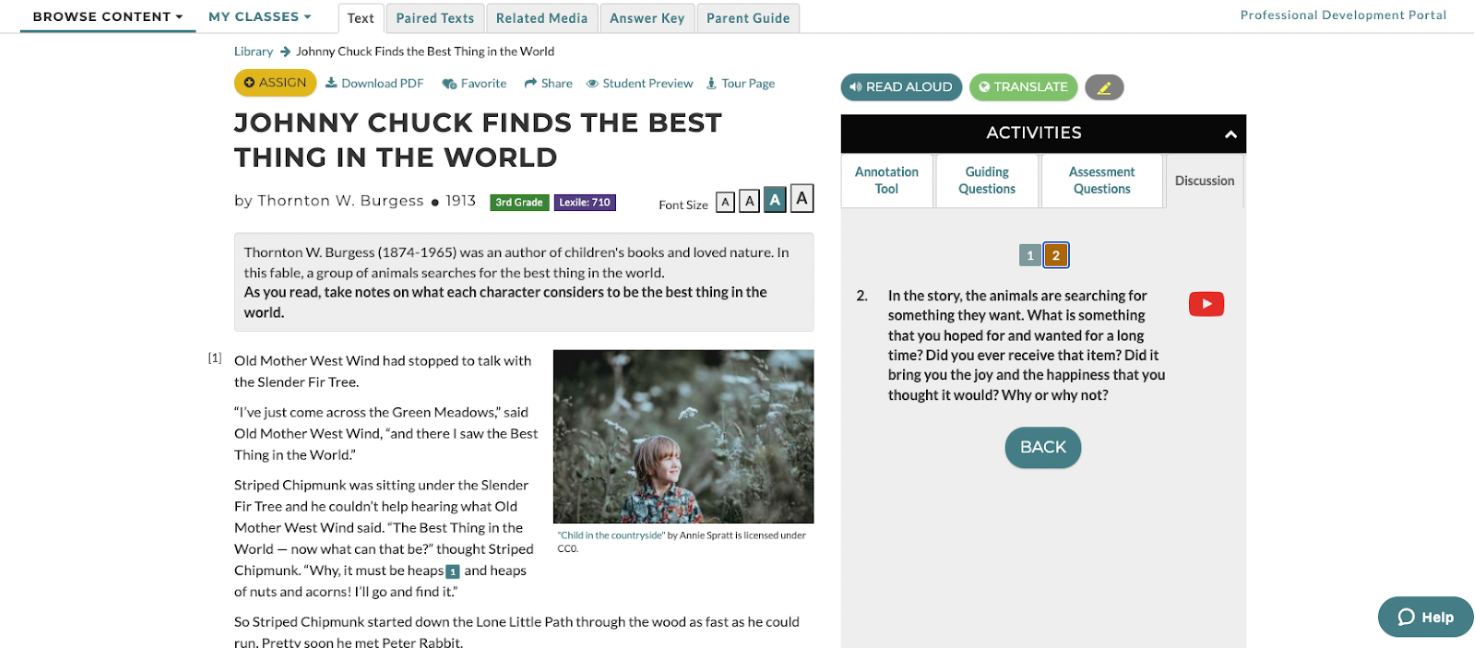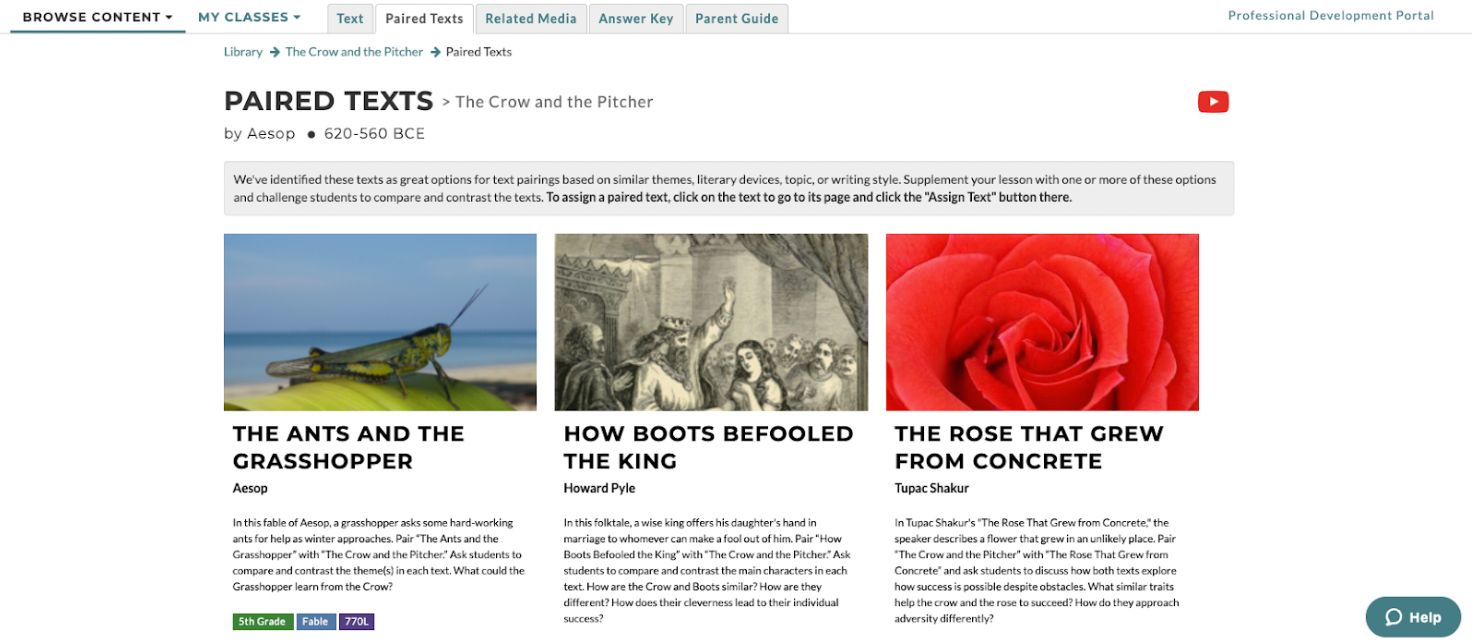These engaging fables for grades 3-5 teach students important life lessons.
Fables are a wonderful way to get students excited about reading and help them learn how authors convey important messages. Students will relate to the strong morals and life lessons in these fun short stories.
Here is an engaging selection of fables for grades 3-5 from CommonLit that will help your students make connections and gain a deeper understanding of how authors develop themes through storytelling.
“Zebra and Wasp” by Clare Mishica (3rd Grade)
In this lighthearted fable, Zebra helps Wasp, who is caught in a spider’s web. Wasp promises to return the favor, but Zebra cannot see how a creature so small could ever help him. Later that day, Wasp notices Lion lurking in the berry bushes, ready to attack Zebra. She rushes down to save Zebra, and Zebra gallops back to his herd.
After reading, have students reflect on the relationship between Zebra and Wasp. Ask Discussion Question 1, “In the fable, Zebra and Wasp help each other. Do you think this makes them friends? Why or why not? Describe a time when you helped a friend in need.” Students can make connections between the text and their own experiences.
“The Sheep and the Pig” by Carolyn Sherwin Bailey (3rd Grade)
In this sweet story, a sheep and a pig decide to build a house together. As they search the woods for a good spot, they meet a rabbit, a goose, and a rooster, who each offer their special skills to help build. The animals build the house together using their different talents and live happily ever after.
After reading, explore how animals use their special skills to build their homes in real life. Show students “How Beavers Build Dams” under Related Media. Then, have students make text-to-text connections by discussing the work that goes into building a home in the text and the video.
“Johnny Chuck Finds the Best Thing in the World” by Thornton W. Burgess (3rd Grade)
In this charming fable, a group of animals try to find the Best Thing in the World. When they run into Johnny Chuck, he tells the animals that he already has everything he needs. The group travels all day but are unable to find the Best Thing in the World. When they return, Old Mother West Wind says that Johnny has the Best Thing in the World, which is being happy with what he has.
This story provides an important opportunity for students to practice gratitude. Ask students Discussion Question 2, “What is something that you hoped for and wanted for a long time? Did you ever receive that item? Did it bring you the joy and happiness that you thought it would? Why or why not?”

“Do What You Can” by Carolyn Sherwin Bailey (3rd Grade)
In this fable, two little raindrops decide to help a hardworking farmer in a drought. The two raindrops fall from the sky, and their actions encourage many more raindrops to do the same. A whole shower falls, saving the farmer’s crop and showing the importance of doing what you can to help others.
Consider assigning CommonLit’s Guided Reading Mode as students read this text. The Guiding Questions will help students monitor their comprehension while reading and develop their understanding of how the two little raindrops made a big difference.
“The Legend of the Dipper” by Carolyn Sherwin Bailey (4th Grade)
In this short story, a young girl ventures out to a spring to collect water for her sick mother. On her way home, the girl meets a dog and a stranger who ask for something to drink. After the girl shares her water, the dipper refills itself. Exhausted, she makes it home and gives her mother water from the dipper, which makes her well again.
This story teaches an important lesson about generosity. To help students develop their understanding of the theme, assign the annotation task, which asks them to take notes on the little girl’s actions on her way back with the water.
“The Elephant and the Crocodile” by H. Berkeley Score (4th Grade)
In this hilarious short story, an elephant and crocodile argue over who is the better animal. A lion offers to help resolve the dispute by challenging them to retrieve a helmet from across the river. Both animals use their unique skills to retrieve the helmet. The lion points out that both animals are wise in their own ways and neither are better than the other.
This story provides a great opportunity for students to make text-to-self connections. Ask Discussion Question 1, “Describe a time when you worked together with someone. How did you both use your strengths to complete a task? Did you encounter any conflicts? If so, how did you handle the conflicts?”
“The Crow and the Pitcher” by Aesop (5th Grade)
In this ancient fable, a thirsty crow finds a pitcher of water with a narrow, long neck. The crow is unable to reach the water and feels as though he will die from thirst. The crow has an idea and drops pebbles into the pitcher until the water rises enough so he can drink.
Consider pairing this text with “The Ants and the Grasshopper” by Aesop under the Paired Texts tab. In this fable, a grasshopper asks hardworking ants for help as winter approaches. After reading both texts, ask students to compare and contrast the themes in each text.

Next Steps
Looking for more stories for elementary students? Check out the fables text set in the CommonLit Library!
If you’re interested in learning all about CommonLit’s free digital literacy program, join one of our upcoming webinars!


